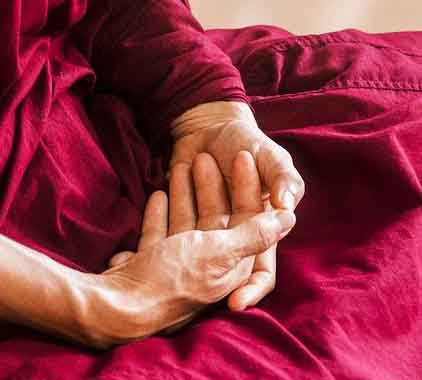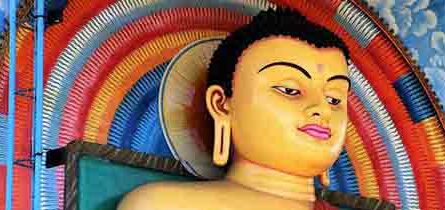I find that the conditions we experience when settling down to meditate are only important for the first couple of minutes. Because after a few minutes I‘m so deep into the focus, or totally zoned out, and am unaware that I even have hands. So what I do with my hands while meditating becomes irrelevant.
However, my meditation journey has been more than twenty-five years in the making. And I do know how important it is in the beginning stages to set up a consistent routine. If we can make our sessions as pleasant and easy as possible, then we are more likely to keep it up…. and twenty-five-plus years later…. haha
So, when beginning meditation, what we do with our hands is important. I say this because if they are not ‘comfortable,’ we will keep moving them around and they will be a major distraction and negatively affect the quality of our meditation.
So let’s explore what the best options are.
What Do I Do With My Hands While Meditating?
Different meditation styles and schools promote different hand positions for different reasons. However, ultimately, it’s your meditation and you must find what works best for you. The time of the day that you meditate and what you want from your session may also influence how you place your hands. Palms open and facing up will give a different experience than when facing down. As will all the different mudras that are promoted by more traditional meditation schools.
What Are The Best Hand Positions For Meditating?
While there are no strict rules, or ‘one solution fits all,’ there is some common sense advice that it pays to follow.
Our hands should not be in any position that interferes with our concentration, restricts the natural flow of our breath, or impedes our energy flow in any way. And they should be in a position that you can sustain throughout your session.
With these things in mind, some of the best positions include:
If you’re sitting with crossed legs….
– Many Buddha statues show the hands, one on top of the other, gently resting on the lap. Palms face upwards. This position is the most natural and requires no effort on your behalf as your hands, arms, and shoulders naturally conform to gravity and can be totally at ease here. 
– One hand resting on each knee with your elbows slightly bent. Your palms can either face up (signifies an openness and sharing of energy with all creation) or down (retaining your energy for yourself and helping to inwardly calm your body and mind.)
– If you straighten your arms, your palms will extend beyond your knees. It’s most comfortable if your palms are facing each other, and I normally have my thumb and forefinger touching while the other three fingers are extended straight out. This is only one mudra. However, you may like to adopt another mudra (explained later) that is more suitable for you while in this position.
If you’re lying down….
– When I lie down to meditate, my arms are extended straight and my palms are usually about one foot or 300mm away from the sides of my body. My intention while meditating lying down is to become as relaxed as possible. So I just allow my hands to find the most natural position where they can remain without becoming uncomfortable.
Standing or mindfulness meditation…..
Our goals while being mindful will all be different, and I imagine most of the time we are more concerned with the activity we are doing (like mindful walking, cooking, or breathing) rather than what position our hands are in.
If we are truly mindful of these other things, our hand position will not be of any concern to us. Our hands will just naturally conform to the activity we are involved in.
Is Hand Position While Meditating Important?
We should do everything we can to make our meditation practice as beneficial as possible. This may mean when in the initial stages of meditating, we will need to try many different things. And with time, you will come to know what works best for you.
It’s important to understand, as I mentioned before, that there are no set rules to follow. And with this in mind, you may meditate with music or without, before eating or after, with eyes opened or closed, sitting down or standing on your head….. just find something that works for you and stick with it…..
 Meditation develops strength of the mind and body awareness. It is a practice in which the results accumulate….. the longer time (not session length but over years) we meditate, the less important the ‘distractions’ become. And this includes hand position.
Meditation develops strength of the mind and body awareness. It is a practice in which the results accumulate….. the longer time (not session length but over years) we meditate, the less important the ‘distractions’ become. And this includes hand position.
Having said there are no ‘rules’ to follow, there are certain traditions that do promote the use of specific hand positions to achieve specific outcomes. They believe that hand position can deepen your practice and unlock energy that is blocked within our bodies.
To achieve their goals, they may suggest any one of the hundred-plus known mudras to help maintain your focus, channel your energy, and maintain your posture.
What Are Mudras And Do They Help With Meditation?
Some meditators maintain that you’re not really meditating unless you are using a mudra! I say maybe they’re missing the whole point of what meditation is all about……
…… and if they are so ‘hung up’ on having the perfect mudra, this is probably the very thing that is preventing them from having a more wonderful meditation session. However, we are all different, and it’s all good!
So, anyway….. mudras are ‘hand positions’ that are adopted by some schools of meditation as well as some spiritual traditions. They are said to enhance specific healing states by focusing the mind on the flow of energy within the body. And depending on the school, they may be accompanied by a specific mantra (a sacred sound repeated to deepen the meditative experience.)
Attention to different states like love, compassion, and joy, serve to promote well-being in our bodies and the surrounding environment. And they are achieved with different fingers connected, different hand orientations, and different pressures.
In a metaphysical sense, we can tap into the creative force of the ‘universal energies’ through different hand configurations because our fingers each represent a different element.
Our thumb represents the void, the index finger is air, the middle finger is fire, the ring finger is water, and the little finger symbolizes earth.
Knowing this is all well and good, but as someone who is not religious or aligned with any particular meditation tradition, it doesn’t help me have a better meditation experience.
So I would err on the side of being practical and encourage you just to have the best experience you can without getting hung up on any specific details of any aspect of meditation, including the hand positions.
Why Do My Hands Heat Up Or Tingle When I Meditate?
– Your hands may heat up while meditating because your blood flow has changed. They may be relaxing in your lap and the blood is flowing down and there is more in your hands than is usual. This is normal and nothing to be concerned about. And it is simple to alleviate by just changing your hand position.
– Your energy is shifting and your hands can become a focal point. I find that my hands, and often the extremities of my whole body tingle and also can vibrate as the energy builds up during specific practices.
Again, this is nothing to worry about. It’s just creating a greater awareness of the physical and energetic dimensions that we are. They are not separate but are always interconnected. However, during our daily lives, we tend to ignore our metaphysical aspects to concentrate on our ‘physical’ lives.
Meditation develops an improved awareness of our other dimensions. However, if you are uncomfortable with this, just get up and move around. It will only take a few minutes at most to return to your normal sensory perception.
Final Thoughts:
 Meditation, as a practice, is an invaluable tool for beneficial personal transformation.
Meditation, as a practice, is an invaluable tool for beneficial personal transformation.
Whatever you do, find a way to incorporate it into your daily routine, and never give up.
So, if you are uncomfortable with any aspects of your practice, change them…. Really, just do things differently so you will find the ‘pleasantness’ in practicing. It’s no big deal, irrespective of what the ‘hard-core’ teachers and meditators will tell you.
Just find a way to place your hands, and set everything else us as best as possible, so that when you meditate, you will have a great experience and will want to do it again and again……
….. and then it’s more than twenty-five years later already





